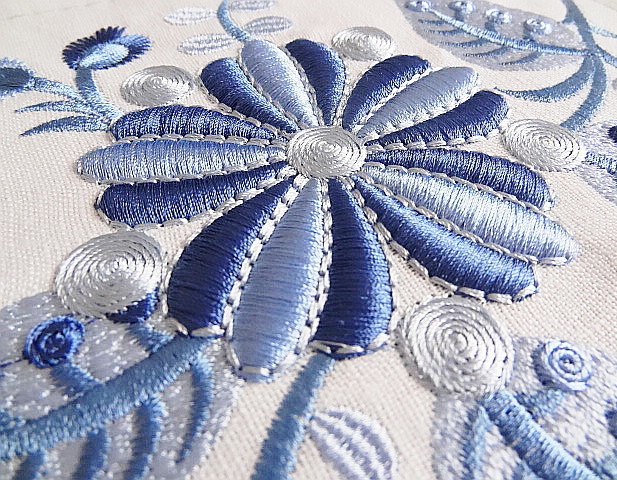If you are looking for original and unusual ideas of decorating the interior, then the Two Golden Thistles Machine embroidery patterns will please you. They combine simplicity and originality, creativity and luxury.
Do you know that a thistle is an official symbol of Scotland? Moreover, colors such as golden and purple are considered royal shades and used to decorate the interior of the king.
From the history of purple
By the way, dozens of centuries ago it was not possible to use such multicolored palette of embroidery threads, as now. To obtain the desired color, people add natural dyes. For example, to get such a purple hue they used mollusks, each with one drop. That is why fabrics of purple color stood very expensive and were considered a symbol of wealth, fame and luxury.
We have already noted that the purple is a royal color. For example, Queen of England Elizabeth I even once forbade everyone, except members close to the royal family, to wear purple. In addition, even earlier, the Roman Emperor Aurelian forbade his wife to buy a purple scarf in the Tigre, because it stood literally as much as a gold of such weight.
Two Golden thistles Machine Embroidery Patterns
Size: 67.5×56.5 mm (2.66×2.22 “), Stitches: 6546
Size: 31.5×31.5 mm (1.24×1.24 “), Stitches: 1599
Formats: .dst, .jef, .pec, .vip, .hus, .pes, .sew, .exp, .dat, vp3, xxx
More accessible fabrics and threads of purple color only began a couple of centuries ago. To this result an event, which generally is not related to textiles at all. In 1856, a young alchemist William Henry Perkin was looking for a cure for malaria and inventing a synthetic mixture of this color, which eventually became a dye for purple.
Two Golden Thistles Machine embroidery patterns will look harmoniously on white tablecloths and napkins, other items of the dining room interior, lampshades for the living room or kitchen, and even curtains. Creativity and uniqueness of the future embroidery project largely depends on your imagination and creativity. In addition, embroidery of these designs will bring you closer to an interesting and original Scottish culture. Moreover, maybe inspire you to study it or visit this country.
Useful advice from Royal Present:
Very often, we receive letters in which our dear customers send photos of items with traces from the hoops that do not disappear, even after a certain time. In such situations, the issue of “To hoop or not to hoop the fabric” is very acute. That is why we decided to tell you about it in detail.
Hoop a fabric, always, if possible. This is the most convenient and correct method of embroidery process. However, you cannot hoop such fabric as velvet, corduroy, silk, thick terrycloth, and in some cases suede. On such tissues, there are traces from the hoops, which is simply impossible to remove. In this case, you should hoop only the stabilizer and attach fabric on top spraying the fabric glue stick.
It is easy to hoop fabrics made of natural fibers. They are stable and dense enough.
Many embroiderers recommend attaching a soft cloth to the inside of the hoops. We advise you to use this method only for slippery, elastic fabrics that do not hold well in the embroidery frame. Yet it is better to buy a special tape to prevent sleeping of the fabric from hoops (Stitchers No-Sleep Hoop Tape).
On some tissues, the hoops traces may disappear right after embroidery or after a while, but remain permanently on others. Therefore, carry out testing it before embroidering. To do this, you can hoop a flap of the same fabric, or, if there are no such possibility, hoop the corner.
P.S. Two Golden Thistles Machine embroidery patterns are universal and you can use it for a wide variety of fabric bases with proper stabilization.
You may also like
Machine Embroidery Design Fantastic flowers

Author: Ludmila Konovalova
My name is Ludmila Konovalova, and I lead Royal Present Embroidery. Embroidery for me is more than a profession; it is a legacy of my Ukrainian and Bulgarian heritage, where every woman in my family was a virtuoso in cross-stitch and smooth stitching. This art, passed down through generations, is part of my soul and a symbol of national pride.
Date: 07.06.2018




 Get Sign-In Link
Get Sign-In Link Login with Google
Login with Google Login with Facebook
Login with Facebook Login with Amazon
Login with Amazon Login with Paypal
Login with Paypal